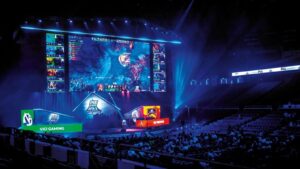
Multiplayer Online Battle Arena (MOBA) games have emerged as a dominant force in the world of online gaming, captivating millions of players slot worldwide and establishing themselves as a prominent genre in the eSports scene. In this article, we will delve into the history and evolution of MOBA games, from their humble beginnings as mods to their current status as global eSports sensations.
The Genesis of MOBA Games
1. The Modding Community
The roots of MOBA games can be traced back to the modding community of popular real-time strategy (RTS) games in the early 2000s. Games like Warcraft III and StarCraft provided modders with a platform to experiment with custom game modes. One such mod, Defense of the Ancients (DotA), is often credited as the precursor to modern MOBAs.
2. DotA: The Pioneering Mod
DotA was created by a modder known as Eul and later developed by Steve “Guinsoo” Feak and IceFrog. It introduced the core mechanics that would define the MOBA genre: teams of heroes with unique abilities, base defense, and the goal of destroying the enemy’s core structure, known as the Ancient or Nexus.
The Rise of Standalone MOBA Titles
1. DotA Allstars
The success of DotA inspired a surge in popularity within the Warcraft III modding community. Multiple versions and iterations of DotA emerged, with DotA Allstars gaining particular recognition. The Allstars version was developed by IceFrog and featured a wide array of playable heroes and a growing competitive scene.
2. The Birth of League of Legends
In 2009, Riot Games released “League of Legends: Clash of Fates,” which would later become simply “League of Legends” (LoL). LoL took the core concepts of DotA and expanded upon them, introducing a streamlined and more accessible experience. Its free-to-play model and continuous updates contributed to its rapid growth and immense popularity.
3. The DotA 2 Era
In 2013, Valve Corporation released “DotA 2,” a standalone game that aimed to recreate the DotA experience with modern graphics and mechanics.
DotA 2 inherited a dedicated player base from the original mod, and its annual tournament, The International, became one of the most prestigious events in eSports, offering multi-million-dollar prize pools.
4. Other Standalone MOBAs
The success of League of Legends and DotA 2 paved the way for other developers to enter the MOBA market. Games like “Heroes of the Storm” (Blizzard Entertainment), “Smite” (Hi-Rez Studios), and “Paragon” (Epic Games) introduced unique gameplay elements and attracted their own followings.
The eSports Revolution
1. Competitive MOBA Scene
As MOBA games gained popularity, they also established themselves as a dominant force in the eSports landscape. Tournaments like “The International” for DotA 2 and the “League of Legends World Championship” offered massive prize pools, drawing attention from professional players, teams, and sponsors.
2. Pro Players and Organizations
Professional players emerged as celebrities within the gaming community, earning salaries, endorsements, and sponsorships. Organizations dedicated to MOBA eSports, such as Team Liquid, Fnatic, and Evil Geniuses, became household names in the gaming world.
3. Global Phenomenon
MOBA tournaments transcended geographical boundaries, attracting viewers from around the world. The eSports scene expanded into Asia, Europe, North America, and beyond, with players and teams hailing from diverse backgrounds.
Gameplay Innovations and Diversification
1. Unique Heroes and Abilities
One of the hallmarks of MOBA games is the diverse roster of playable heroes, each with their own abilities and playstyles. Developers continually introduce new heroes and rework existing ones to keep the gameplay fresh and balanced.
2. In-Game Items and Strategy
MOBAs emphasize strategic decision-making through item purchases, hero selection, and teamwork. The dynamic nature of matches, where no two games are identical, adds depth and replayability to the genre.
3. Evolving Maps and Objectives
Maps in MOBA games are not static; they evolve over time. Developers introduce new maps and objectives to keep players engaged and challenge their adaptability. This approach ensures that gameplay remains exciting and unpredictable.
Challenges and Controversies
1. Toxicity and Harassment
The competitive nature of MOBA games has also given rise to issues of toxicity, harassment, and negative player behavior.

Developers have implemented systems to combat these problems, such as reporting tools, penalties, and behavioral scoring.
2. Balancing Act
Balancing the multitude of heroes and their abilities is an ongoing challenge for developers. A well-balanced game ensures that all heroes are viable choices and prevents certain heroes from dominating the meta.
3. Monetization Models
The free-to-play model, which many MOBAs employ, relies on in-game purchases for revenue. Developers must strike a balance between offering optional cosmetic items and avoiding pay-to-win mechanics that can alienate players.
The Future of MOBA Games
1. Emerging Titles
The MOBA genre continues to evolve with the release of new titles. Games like “Wild Rift” (a mobile version of League of Legends), “Arena of Valor” (Tencent’s mobile MOBA), and “Battlerite” (an arena brawler) have entered the arena, catering to different platforms and player preferences.
2. Cross-Platform Play
Cross-platform play has become a trend in gaming, allowing players on various devices to compete against each other. MOBAs are increasingly adopting this feature, expanding their player base and fostering a more inclusive gaming environment.
3. Continued eSports Growth
The eSports scene for MOBA games shows no signs of slowing down. Tournaments are expected to offer even larger prize pools, and professional players will continue to push the boundaries of skill and strategy.
4. Virtual Reality (VR) and Augmented Reality (AR)
The potential for VR and AR in the MOBA genre is an exciting prospect. These technologies could provide a more immersive gaming experience and open up new avenues for strategic gameplay roulette online.
Conclusion
The journey of MOBA games, from humble mods to global eSports phenomena, is a testament to the power of innovation and community-driven development. These games have redefined the way we approach competitive gaming, offering endless excitement and opportunities for players and enthusiasts alike. As MOBAs continue to evolve, their influence on the gaming industry and eSports will undoubtedly persist, ensuring that the genre remains a vibrant and vital part of the gaming landscape for years to come.













